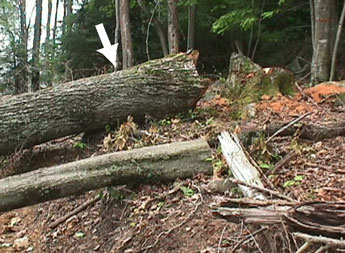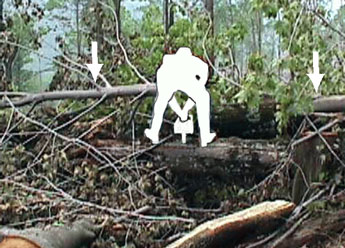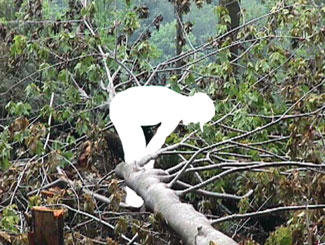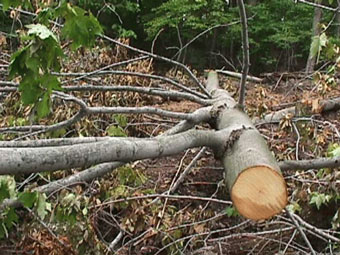
Case: 03WV012-01
Release Date: July 25, 2003
Logging Company Owner Dies After Being Struck by a Set-back as He Began Topping Another Tree in West Virginia
SUMMARY
On June 9, 2003, a 53-year-old male logging company owner (the victim) died of injuries sustained when he was struck by a still-standing maple that he had attempted to fell earlier. When his final cut failed, he decided to let the set-back stand and move on to a large red oak located 11 feet to the side and slightly uphill from the standing maple. The maple was 10 inches in diameter at breast height (DBH) and 65 feet tall. The oak was approximately 40 inches DBH. After felling the oak, he walked down hill to begin topping it. He positioned himself on top of the oak about 40 feet downhill from the maple. As he began his first cut, a gust of wind blew the set-back over. Two of his employees, who witnessed the incident, reported that they saw the set-back begin to fall toward him. They yelled a warning to the victim but he was unable to hear them due to his running chainsaw. The victim was struck from his right rear receiving severe multiple injuries to his upper body. One of the workers drove the skidder to the operation’s landing site and notified a truck driver who then called the local EMS. The other worker remained with the victim for approximately 30 minutes, at which time the EMS arrived and pronounced the victim dead.
The WV FACE Investigator concluded that, to reduce the likelihood of similar occurrences, employers should:
INTRODUCTION
On June 9, 2003, a 53-year-old male logging company owner (the victim) died of injuries sustained when he was struck by a still-standing maple that he had attempted to fell earlier. On June 11, 2003, the West Virginia FACE Investigator was notified of the death by the West Virginia Bureau of Employment Program’s Safety and Loss Division. The incident was reviewed with a West Virginia Division of Forestry (WVDOF) representative, who then accompanied the investigator to the site where an investigation was conducted on June 19, 2003. A contracted truck driver, who was present the day of the incident, was interviewed. The incident site was examined and photographed. Other informational sources and contacts included: death certificate, medical examiner’s report, newspaper articles, and OSHA.
The privately-owned 8 acre timber stand was being selectively logged for saw timber and pulpwood.
The employer in this incident was a commercial logging company which had been
in business for 11 years. The usual workforce totaled 4. At the time of the
incident, the workforce totaled 3 including the victim/owner. The company had
a designated safety director (victim/owner) as well as a written safety program.
In addition, safety meetings were held periodically. The company had a fatality
16 months earlier when an unrestrained heavy equipment operator died after the
skidder he was operating ran over him.
The victim/owner held Certified Logger status in West Virginia. [Note: The Logging
Sediment Control Act of West Virginia (1992) requires that each timbering operation
in West Virginia be supervised by a certified logger. To become a certified
logger, an individual is required to successfully complete training and pass
a test for best management practices (a soil erosion prevention plan) and chain
saw safety as well as possess a current first aid card.1]
The victim/owners’s job at the time of the incident was that of timber cutter. He had approximately 11 years of experience.
At the time of the incident, the victim was not doing his usual job of coordinating and operating the landing area. His timber cutter had not reported for work for the past two days, therefore the victim was felling timber. He had been felling timber approximately 7 hours prior to the incident. At the time of the incident, he was wearing a hard hat and safety glasses.
INVESTIGATION
On June 9, 2003, a 53-year-old male logging company owner (the victim) died of injuries sustained when he was struck by a still-standing maple that he had attempted to fell earlier. His final cut failed and he decided to let the set-back stand and move on to a large red oak located 11 feet to the side and slightly uphill from the standing maple (see Figure 1). The maple was 10 inches in diameter at breast height (DBH) and 65 feet tall. The oak was approximately 40 inches DBH. After felling the oak, he walked down hill to begin topping it. He positioned himself on top of the oak about 40 feet downhill from the standing maple (see Figure 2). As he began his first cut, a gust of wind blew the set-back over striking him from the right (see Figure 3). Two of his employees who witnessed the incident reported that they saw the set-back begin to fall. They yelled a warning to the victim, but he was unable to hear them due to his running chainsaw. The victim was struck form his right rear receiving severe multiple injuries to his upper body (see Figure 4). One of the workers drove the skidder to the operation’s landing site and notified a truck driver who then called the local EMS. The other worker remained with the victim for approximately 30 minutes, at which time the EMS arrived and pronounced the victim dead.
CAUSE OF DEATH
The medical examiner’s report listed the immediate cause of death as multiple blunt force traumatic injuries.
RECOMMENDATIONS/DISCUSSION
Recommendation # 1: Employers should ensure that tree fellers utilize felling wedges in addition to proper felling techniques on trees with back lean.
Discussion: Trees with back lean should be wedged to fall in the desired direction. After establishing an open faced notch and determining the required amount of hinge wood, the feller should begin the back cut. As soon as the back cut is deep enough, a wedge should be driven into the cut. The back cut should continue leaving a hinge at least 1/10 the tree’s diameter. When the back cut is complete the tree should start to fall. If not, felling may be aided by driving the wedge further into the cut. Having implemented the use of a wedge to successfully fell the maple would have abated the hazard and ensured that the tree would not have fallen on the victim.
Note: When using the bore cut and release, the wedge should be driven into the chainsaw cut on the side of the release tab which has the tree’s weighted side lean (bad side).
Recommendation # 2: Employers should ensure that set-backs are immediately
removed mechanically before continuing any work.
Discussion: The victim’s position as he began to top the large oak placed him within 40 feet of a 65 foot tall set-back. Set-backs should be mechanically removed as soon as possible after creation. OSHA Regulation 29 CFR 1910.266 (h)(1)(vi) requires that each danger tree, including set-backs snags, and lodged trees, be felled, removed, or marked and avoided.2 Where immediate removal is not feasible, tagging/flagging will alert workers to maintain a two-tree length safety buffer until mechanical removal is possible. Removal using mechanical techniques, such as a dozer or skidder, would have minimized the victim’s exposure to the potential risk. At the time of the incident, mechanical equipment was available. In fact, the victim was within 120 feet of his equipment operators. Had the set-back been removed or flagged and the required two tree length buffer zone (approximately 130 feet) been maintained by the victim, this incident might have been prevented.
Recommendation # 3: Employers should ensure that company policies and practices
concerning hazard abatement are consistently followed by all.
Discussion: The evaluation of tasks to be performed at the work site form the basis for the development, implementation, and enforcement of a safety program. The key elements for this program should include, at a minimum, training in hazard identification and the avoidance and abatement of these hazards. Additionally, the program should display management’s leadership and commitment to the consistent abatement of all hazards. In this incident, the owner of the company was fatally injured when he decided to continue working near a self created hazard with established and accepted company wide methods of abatement. It was reported that the standard operating procedure was to summon assistance from equipment operators and mechanically fell all set-backs. It is unclear as to why the victim made the decision to by-pass the usual hazard abatement procedure. If the standard operating procedures concerning set-backs had been followed the hazardous situation may have been avoided.
ILLUSTRATIONS
 |
| Figure l. The photo shows the
butt and stump of both trees. The white arrow depicts the large red oak.
The maple, which set-back and later became the fatal energy source is
in the foreground. |
 |
| Figure 2. The photo shows the
victim's position when struck-by the maple. The white arrows point to
the fatal energy source. The missing section was removed to allow emergency
care providers access to the victim. |
 |
| Figure 3. The victim's position
when struck from his right by the fatal energy source. |
 |
| Figure 4. This photo shows the
fatal energy source as would be seen from the victim's perspective. |
FATALITY ASSESSMENT AND CONTROL EVALUATION PROGRAM
The WVU Center for Rural Emergency Medicine, through a contract with the West Virginia Department of Health and Human Resources and Bureau for Public Health, conducts investigations on the causes of work-related fatalities within the state. The goal of this program is to prevent future fatal workplace injuries. West Virginia FACE intends to achieve this goal by identifying and studying the risk factors that contribute to workplace fatalities, by recommending intervention strategies, and by disseminating prevention information to employers, employees, trade associations, unions, equipment manufacturers, students, teachers, and others with an interest in workplace safety.
Please use information listed on the Contact Sheet on the NIOSH FACE website to contact In-house FACE program personnel regarding In-house FACE reports and to gain assistance when State-FACE program personnel cannot be reached.